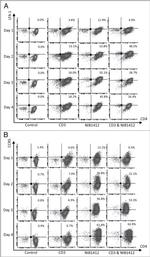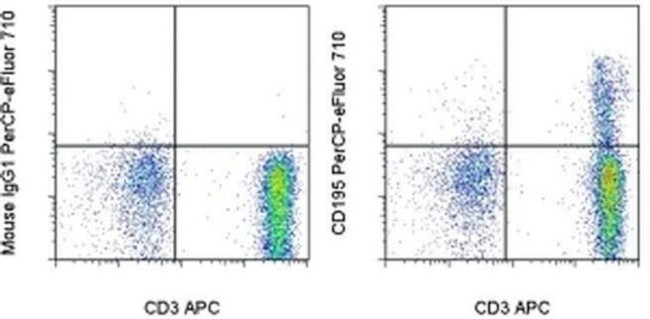Search Thermo Fisher Scientific
Invitrogen
CD195 (CCR5) Monoclonal Antibody (NP-6G4), PerCP-eFluor™ 710, eBioscience™
FIGURE: 1 / 3
CD195 (CCR5) Antibody (46-1956-42) in Flow



Product Details
46-1956-42
Species Reactivity
Published species
Host/Isotype
Recommended Isotype Control
Class
Type
Clone
Conjugate
Excitation/Emission Max
Form
Concentration
Purification
Storage buffer
Contains
Storage conditions
Shipping conditions
RRID
Product Specific Information
Description: The NP-6G4 monoclonal antibody reacts with human CD195 (CCR5), an approximately 45 kDa member of the G protein-coupled receptor (GPCR) superfamily that binds chemokines including MIP-1a, MIP-1b and RANTES. Human CCR5 is expressed on resting T cells with a memory/effector phenotype, monocytes, macrophages and immature dendritic cells. CCR5 functions as a receptor to direct the chemotaxis of lymphocytes, and is the primary co-receptor for macrophage-tropic Human Immunodeficiency Virus Type 1 (HIV-1), which binds CCR5 through gp120.
Applications Reported: This NP-6G4 antibody has been reported for use in flow cytometric analysis.
Applications Tested: This NP-6G4 antibody has been pre-titrated and tested on normal human peripheral blood cells. For optimal performance, it is recommended that staining with NP-6G4 be done at 37°C for 1 hour in Flow Cytometry Staining Buffer (Product # 00-4222-57). This can be used at 5 µL (0.125 µg) per test. A test is defined as the amount (µg) of antibody that will stain a cell sample in a final volume of 100 µL. Cell number should be determined empirically but can range from 10^5 to 10^8 cells/test.
PerCP-eFluor® 710 emits at 710 nm and is excited with the blue laser (488 nm); it can be used in place of PerCP-Cyanine5.5. We recommend using a 710/50 bandpass filter, however, the 695/40 bandpass filter is an acceptable alternative. Please make sure that your instrument is capable of detecting this fluorochrome.
Fixation: Samples can be stored in IC Fixation Buffer (Product # 00-822-49) (100 µL cell sample + 100 µL IC Fixation Buffer) or 1-step Fix/Lyse Solution (Product # 00-5333-54) for up to 3 days in the dark at 4°C with minimal impact on brightness and FRET efficiency/compensation. Some generalizations regarding fluorophore performance after fixation can be made, but clone specific performance should be determined empirically.
Excitation: 488 nm; Emission: 710 nm; Laser: Blue Laser.
Filtration: 0.2 µm post-manufacturing filtered.
Target Information
Human immunodeficiency virus (HIV) and related virus require coreceptors, in addition to CD4, to infect target cells. Some G protein-coupled receptors including CCR5, CXCR4, CCR3, CCR2b and CCR8 in the chemokine receptor family, and four new human molecules GPR15, STRL33, GPR1 and V28 were recently identified as HIV coreceptors. Among them, CCR5 (CC-CKR-5) is a principal coreceptor for macrophage- and dual-tropic HIV-1 strains fusion and entry of human white blood cells. CCR5 is required for the infection by HIV-1, HIV-2, and SIV. The beta-chemokines RANTES, MIP-alpha and MIP-beta are the ligands for CCR5 and prevent infection by M-tropic HIV-1. CCR5 associates with the surface CD4-gp120 of HIV complex and leads to membrane fusion and virus entry of target cells. The amino-terminal domain and the extracellular loops of CCR5 serve as HIV biding sites. CCR5 messenger RNA is expressed in lymphoid organs and monocytes.
For Research Use Only. Not for use in diagnostic procedures. Not for resale without express authorization.
How to use the Panel Builder
Watch the video to learn how to use the Invitrogen Flow Cytometry Panel Builder to build your next flow cytometry panel in 5 easy steps.
Bioinformatics
Protein Aliases: C-C chemokine receptor type 5; C-C CKR-5; C-C motif chemokine receptor 5 A159A; CD195; CD195 antigen; chemokine (C-C motif) receptor 5; chemokine receptor CCR5; CHEMR13; HIV-1 fusion coreceptor
Gene Aliases: CC-CKR-5; CCCKR5; CCR-5; CCR5; CD195; CKR-5; CKR5; CMKBR5; IDDM22
UniProt ID: (Human) P51681
Entrez Gene ID: (Human) 1234

Performance Guarantee
If an Invitrogen™ antibody doesn't perform as described on our website or datasheet,we'll replace the product at no cost to you, or provide you with a credit for a future purchase.*
Learn more
We're here to help
Get expert recommendations for common problems or connect directly with an on staff expert for technical assistance related to applications, equipment and general product use.
Contact tech support

